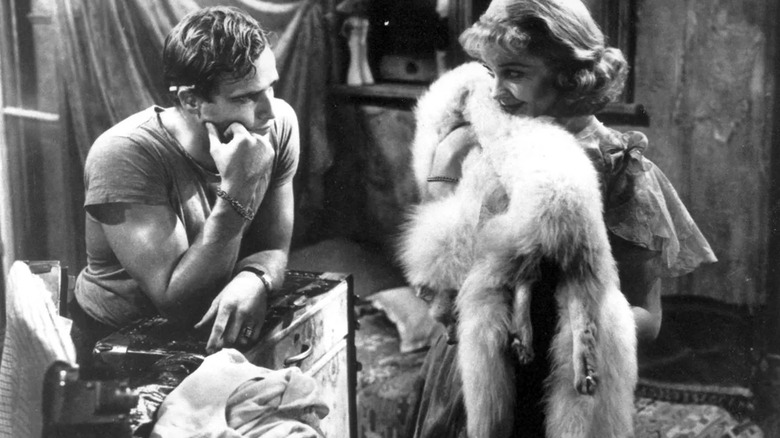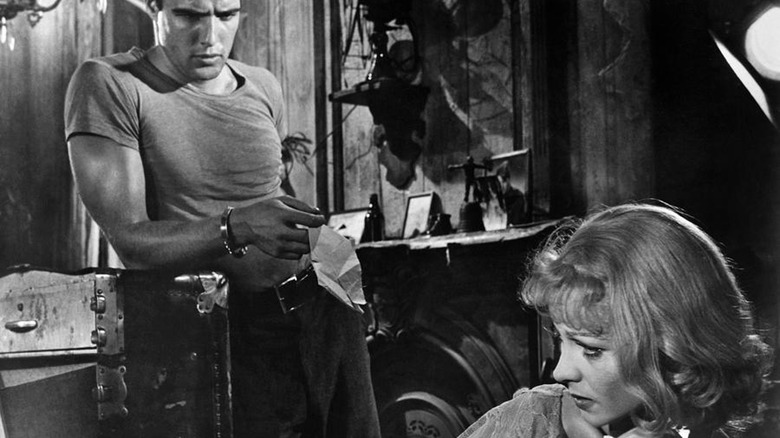A Superstitious Vivien Leigh Refused To Shoot A Key Scene In A Streetcar Named Desire
In Tennessee Williams' play "A Streetcar Named Desire," Blanche DuBois desperately clings to certain beliefs. She is keenly intent on reinforcing the societal values and morals inherent in her aristocratic lineage, shunning realism for the magic of a nostalgic past that hides something darker, and repressing her guilt with the help of self-soothing mechanisms. When faced with the terrible nature of reality, which culminates in the character of her brother-in-law Stanley, Blanche is forced to reckon with the cycles of the violence that mark her existence, along with the precious fantasies woven to protect herself from true growth or healing. When she smashes a mirror, the delusions also shatter, with fantasy having no hold on her perception of reality anymore.
The mirror-smashing scene is seminal to understanding Blanche in Williams' play, and "On the Waterfront" director Elia Kazan's film adaptation of the story also dramatizes this to chilling effect, as the character's aversion to her own reflection forces her to trigger this metaphorical wake-up call. After the mirror-smashing, Blanche (Vivien Leigh) contrasts Stanley's (Marlon Brando) brutish nature with another male character, whom she describes as a "gentleman" who is kind and gentle. However, Stanley bluntly demolishes this delusion, causing Blanche to feel like she is surrounded by "lurid reflections" and menacing shadows — an uncomfortable reminder of the horrors that weigh heavy upon her.
However, the film features this second mirror-smashing scene to also symbolize the sexual violence inflicted upon her by Stanley and underline the imagery of Blanche's fractured psyche. Per Sam Staggs' "When Blanche Met Brando: The Scandalous Story of "A Streetcar Named Desire," Leigh was "superstitious" and refused to break the mirror for the scene, as she believed it would bring bad luck for a long time.
A lot of mirrors were smashed in A Streetcar Named Desire
In his book, Staggs states that Leigh did not wish to smash the mirror for the scene as "no actor would risk seven years of bad luck," and Kazan accommodated this request by letting a stuntman do it instead. To get the scene right, where Blanche throws a bottle at the mirror to smash it, 11 mirrors were broken until it was deemed perfect. Karl Malden, who played Mitch in the film, recalled that "[Kazan] made a point of wanting us to try to accommodate Vivien" as much as possible, as the actor had a rather tough time on set due to myriad factors, both personal and professional (via The Hollywood Reporter).
Apart from the slight symbolic enhancements to the play's mirror scene, Kazan's adaptation made several changes to accommodate the story within the cinematic medium, such as the addition of various locations to make the world feel more connected and lived in. Although this aspect helps establish the kind of world the characters inhabit, the one-location setting of the play adds a layer of condensed claustrophobia that Blanche has to wrestle with while validating her fantastical bubbles to repress trauma. A key change in the film, however, that fares better than the play is the ending, where Blanche's sister, Stella (Kim Hunter) takes a more empowered, humane stance after learning about her husband's troubling, almost sadistic penchant for violence.
Although Kazan's Best Picture-nominated "Streetcar" is as complicated and controversial as its source material, it tackles layered themes head-on and poses the integral question of whether realism is a form of cruelty. This kind of unforgivable violence, which breaks illusions crafted to protect oneself from harm, is no better than the naive hope of relying on the kindness of strangers.

